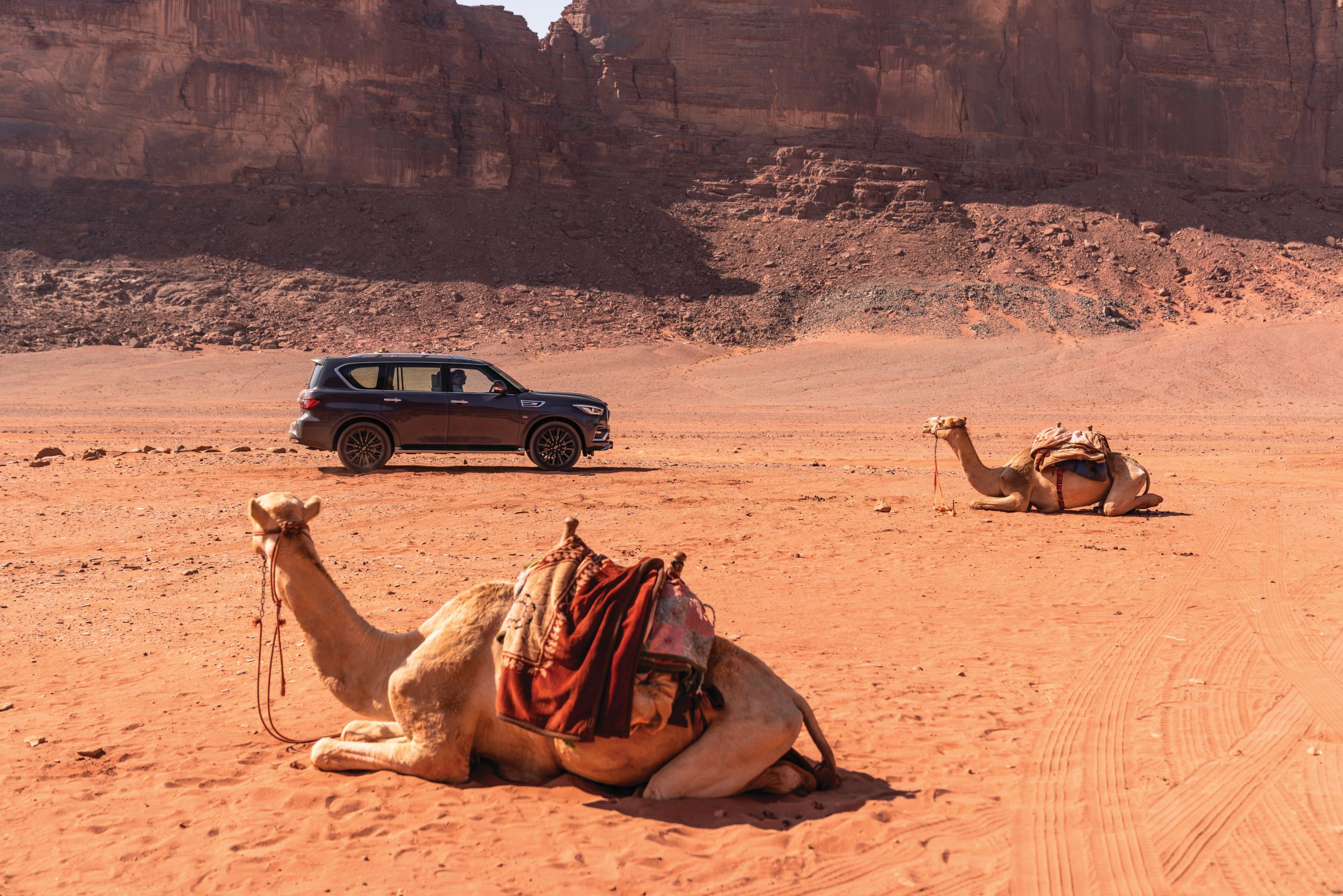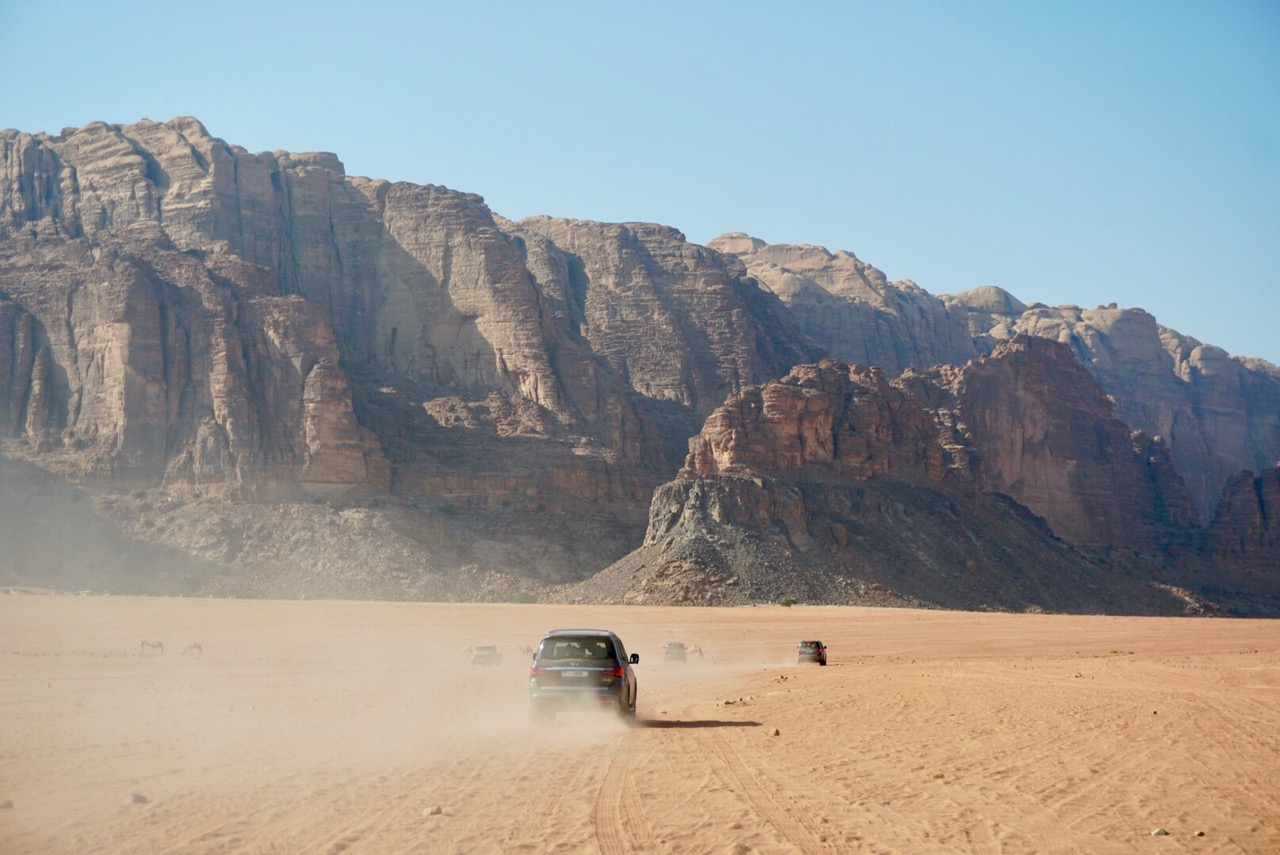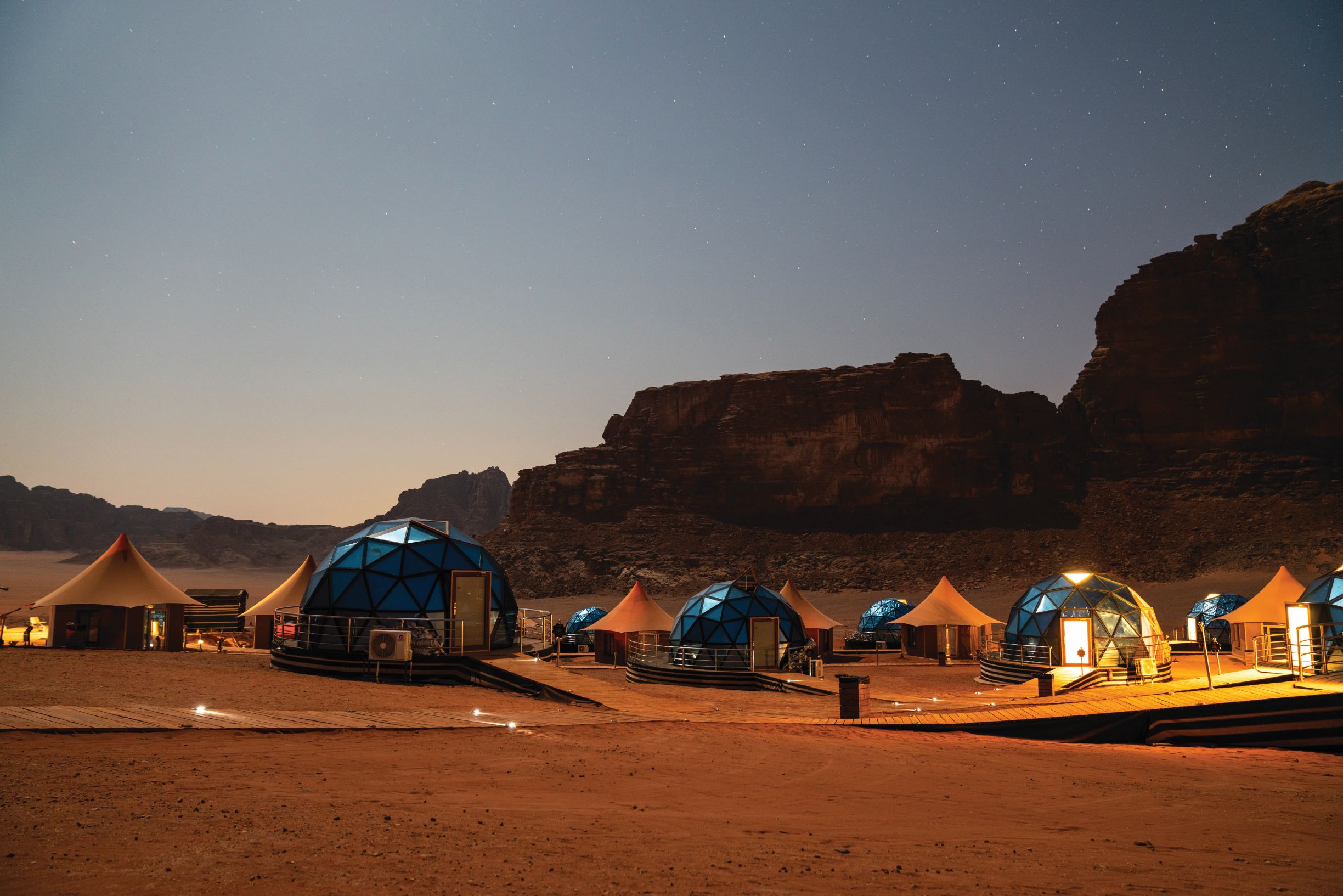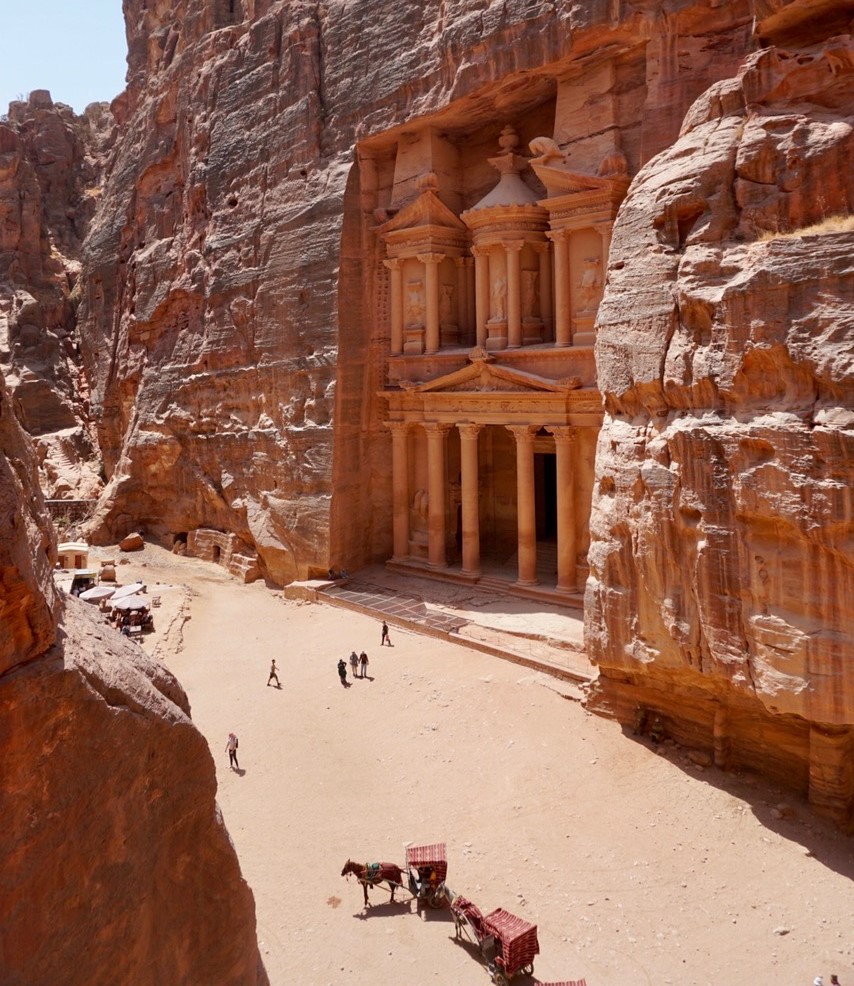We Took A Wild Ride Across The Jordanian Desert In An Infiniti QX80
It’s way better than riding a camel.

The sun is torrid, and there is no breeze. The entire world feels like an oven set on broil, merciless and angry. And yet we’re grinning idiotically like drunks with bellies full of the good stuff. The reason for our joy is simple: we’re driving high-tech 4x4s through an ancient, rugged landscape. It’s like a cheat code of mechanical differentials, burly body-on-frame fortitude and petrol engines so big they can swallow the nearby cliffs.
The thrill is hard to articulate. Barreling down an open swathe of Arab desert, the pedal is floored as the world opens up before us. All around the cliffs of Wadi Rum, some spiraling almost 3,000-feet into the sky, rise from the red soil like sentries. The sun is about to set over Jordan, hovering not too far above the horizon, so it takes turns shining hot and dipping under the tallest of mountains, playing peek-a-boo with the senses.
Suddenly to our left another Infiniti QX80 in our caravan zooms up bravely, mammoth 5.6-liter V8 rumbling, the mechanics clanging on bigger dips, rooster tails of red plumage swirling from behind its rear axle. It doesn’t feel exactly like a race, maybe more like a dance. I hear loud hollering from inside the cabin, and with a bit of surprise I realize it’s not coming from my co-driver Matt but rather from my own open mouth.

We just left the ruins and bubbling spring which allegedly played home to T.E. Lawrence in 1916 as he prepped the Great Arab Revolt— as dramatized in David Lean’s legendary 1962 epic Lawrence of Arabia—and we’re now pulling up to a towering edifice of stone called the Seven Pillars of Wisdom. The moniker is an ode to Lawrence, but it’s not because he named it; rather it was dubbed so after the British Army officer’s death, as an homage to his memoir of the same name. Let’s just say that Lawrence’s shadow looms large over Wadi Rum.
Sitting on the warm hood we watch the sun slowly disappear, lighting up the Seven Pillars with a torch. The land here is ruddy, a rich ochre that meets the orange sky like a Rothko painting. The hue is unlike any you’ve ever seen. It’s been described as everything from blood to brick red, but that doesn’t quite do it justice. It’s more like a pungent rust. The sky as well; both are so rich it’s as if God turned the saturation slider on His Instagram filter up a notch too high.
When the sun has completed its burlesque show we jump back in the QX80s and point our bows to another corner of Wadi Rum. Nestled in an alcove deep in the canyons, the Memories Aicha Luxury Camp encompasses an array of geodesic domes, their glass facets shining like weird diamonds in the gloaming.
https://www.instagram.com/p/B2hEmo-FdUu
For dinner that night we eat in a cave on the cliff wall, and someone pulls out a bottle of Moët & Chandon from a bucket of ice for a celebratory toast. Exhausted, we stay up smoking shisha, taking long pulls of the sweet tobacco as the curls of smoke rise up into the darkness.
It’s still deep evening outside when we awake at 4 a.m., but you can make out the silhouette of nearby cliffs through our dome windows. Walking out into the desert, washed entirely in purple moonlight, the heart swells at the feeling of acute loneliness and isolation.
Dubbed the Valley of the Moon, you just might mistake Wadi Rum for being there, but it’s actually more like other heavenly bodies. Mars, or maybe the 5th moon of Saturn. After all not only was The Martian filmed here but also Rogue One: A Star Wars Story, Star Wars: The Rise of Skywalker, Prometheus and even the new Dune.
We load up in the SUVs and head north, beginning a long four-hour trek to a city founded in the 4th century BC by a nebulous civilization known as the Nabataeans: Petra. It’s sleepy and quiet in the cabin as “Scheherazade”—Russian composer Nikolai Rimsky-Korsakov’s symphonic ode to The Arabian Nights—oozes out of the Bose Performance Series Audio system’s 17 speakers.
https://www.instagram.com/p/B2zGK6olPwA
A perfect soundtrack, as we’re on the same dirt road Lawrence once drove his Ford Model T through. Grainy footage exists of that journey, the Ford’s rickety wood wheels looking like they’re holding together for dear life. All around the Lieutenant Colonel ride Arabs on proud horses, muscles rippling in the sun.
That was only a century ago, but with steam locomotives, single shot rifles and 20-horsepower Ford Model T’s for transportation (or 1-horsepower horses) it seems like another lifetime. Still, the overall aura of that era persists here—even if we’re seeing it through the windshield of a 21st century Infiniti.
We arrive at Petra just after dawn, disembark and begin our long walk down the narrow canyon to the Nabataean capital city. As the hub of their trading empire, Petra amassed fabulous wealth during the kingdom’s peak, and its placement at the center of a natural geological fortress made it almost impenetrable.

The walk in alone requires a mile-long hike through the Siqit: a narrow fault cutting through the earth, with smooth stone walls towering above. Parts of the road underfoot date back two millennia; you can make out ruts from wagon wheels polished into the cobblestone. As you descend, horses with carriages clip-clop past, blurring the time/ space continuum.
The hike is like an Ayahuasca tea ceremony preparing your mind for takeoff. When you finally break from the Siq into the first plaza— the vertiginous Al-Khazneh (aka The Treasury) opening up before you, carved out of the sheer rock face—your heart drops into your stomach, and it feels like you’ve just been clobbered over the head with an anvil. Even if you’ve traveled the world over, twice, you will have never seen anything like what you will witness walking through the city’s corridors.
Prehistoric skyscrapers carved from the sandstone rise up on either side, their facades remarkably unblemished, ornate and grand. As with many, the first time I saw this place—as the secret chamber of the Holy Grail—was in Indiana Jones and the Last Crusade. But no film, even Indy, can compare to the real thing. Al B’doul Bedouins, eyes painted black like Dothraki, ride by on camels and mules, offering tea and selling their wares.
Matt and I break off at the amphitheater and climb to the High Place of Sacrifice for a better view. At the top of the 700 steps the wind blows so fierce it almost cools the air. We look down entranced at the carved city and Jabal Al-Madbah, which some believe to be the Biblical Mount Sinai. Sweat beads on our foreheads and streams down our temples.

Hours, maybe days, later we climb down the long stairs and head back up the long stretch of the Siqit to the Petra Guest House Hotel at the lost city’s entrance, the one locus of modernity in the area. As soon as we arrive I feel strangely repulsed by the buzz of tourists hammering away on their phones, so I quickly duck back outside.
Remembering a cave door we passed en route, I find it and enter; built as a tomb 2,000 years ago, the Cave Bar is appropriately dark, still and cool. I pull up a stool at the end of the room and signal the bartender. Pointing to the draft spout I order a tall mug of Carakale, the local beer, and he delivers it with a smile and a salaam. I drink deep. It is cold, and delicious.
